Enhancing Furniture Manufacturing with 3D Scanning
Abstract
:1. Introduction
2. An Up-To-Date Review of 3D Scanning in the Furniture Industry
3. Experimental Setup and Methodology
3.1. Experimental Setup
3.2. Three-Dimensional Scanning—Collect Raw Data
3.3. Processing of 3D Scans
3.4. Development of CAD 3D Models
3.5. Analysis of the Dimensional Accuracy of Created CAD Models
4. Results
4.1. Case Study No. 1
4.2. Case Study No. 2
4.3. Case Study No. 3
4.4. Case Study No. 4
5. Discussion
- The designer often assembles the initial full-scale prototypes of designed furniture items manually. To replicate these prototypes in large-scale or series production using traditional manufacturing methods such as CNC machining, engineers must create a 3D CAD model. When generating 3D CAD models from physical objects, 3D digitization offers the most time-efficient and dimensionally accurate solution. Case study No. 1 showcases a practical application of this technology.
- The primary area of utilization of 3D digitization in furniture production is metrology, which is used to verify the dimensional precision of fabricated components. A virtual point cloud 3D representation can be generated using 3D digitization, and this representation can be juxtaposed with the ideal 3D CAD representation of the same product so dimensional discrepancies can be gauged. This is not a frequently utilized application of 3D digitization in furniture because furniture items typically do not necessitate high dimensional precision. Examples of these applications are scientific documents [20] and [22] and case studies No. 2 and 3.
- Three-dimensional scanning can preserve and reconstruct antique furniture. Digital storage eliminates the complexities of storing actual antique furniture. Additionally, digital representation can be easily distributed to others and is openly accessible to everyone worldwide for analysis. This application is illustrated in the literature [17,18,19] and case study No. 4.
- Furniture production firms often need to replicate more duplicates of previously manufactured products (reverse engineering). Technical documentation of these products is often deficient or nonexistent. Faithfully reproducing these products begins with 3D digitization as a foundation for CAD representation. These application illustrations are featured in case studies No. 1, 2, and 3.
6. Conclusions
- Three-dimensional scanning allows the creation of accurate 3D CAD models from physical prototypes, streamlining the development process of new furniture.
- Manufacturers can verify the dimensional accuracy by comparing the scanned components with the CAD models, leading to a higher-quality end product.
- Three-dimensional scanning facilitates the preservation, analysis, and reconstruction of antique furniture pieces.
- This technology enables replicating existing furniture products, even with incomplete or missing technical documentation.
Author Contributions
Funding
Data Availability Statement
Conflicts of Interest
References
- Batra, V.; Kumar, V. Developments in Three-Dimensional Scanning Techniques and Scanners. In Emerging Trends in Mechanical Engineering; Das, L.M., Kumar, N., Lather, R.S., Bhatia, P., Eds.; Lecture Notes in Mechanical Engineering; Springer: Singapore, 2021; pp. 59–88. ISBN 9789811583032. [Google Scholar]
- Zheng, P.; Wang, H.; Sang, Z.; Zhong, R.Y.; Liu, Y.; Liu, C.; Mubarok, K.; Yu, S.; Xu, X. Smart Manufacturing Systems for Industry 4.0: Conceptual Framework, Scenarios, and Future Perspectives. Front. Mech. Eng. 2018, 13, 137–150. [Google Scholar] [CrossRef]
- Javaid, M.; Haleem, A. Industry 4.0 Applications in Medical Field: A Brief Review. Curr. Med. Res. Pract. 2019, 9, 102–109. [Google Scholar] [CrossRef]
- Arvanitis, G.; Lalos, A.S.; Moustakas, K. Robust and Fast 3-D Saliency Mapping for Industrial Modeling Applications. IEEE Trans. Ind. Inf. 2021, 17, 1307–1317. [Google Scholar] [CrossRef]
- Haleem, A.; Javaid, M.; Singh, R.P.; Rab, S.; Suman, R.; Kumar, L.; Khan, I.H. Exploring the Potential of 3D Scanning in Industry 4.0: An Overview. Int. J. Cogn. Comput. Eng. 2022, 3, 161–171. [Google Scholar] [CrossRef]
- Skorupińska, E.; Hitka, M.; Sydor, M. Surveying Quality Management Methodologies in Wooden Furniture Production. Systems 2024, 12, 51. [Google Scholar] [CrossRef]
- Krawiec, P.; Domek, G.; Warguła, Ł.; Waluś, K.; Adamiec, J. The Application of the Optical System ATOS II for Rapid Prototyping Methods of Non-Classical Models of Cogbelt Pulleys. MATEC Web Conf. 2018, 157, 01010. [Google Scholar] [CrossRef]
- Krawiec, P.; Czarnecka-Komorowska, D.; Warguła, Ł.; Wojciechowski, S. Geometric Specification of Non-Circular Pulleys Made with Various Additive Manufacturing Techniques. Materials 2021, 14, 1682. [Google Scholar] [CrossRef] [PubMed]
- Chowdary, B.V.; De Noon, A.; Ali, F.; Imbert, C.A.C. An Investigation for Improvement of the 3D-digitization Process: A Reverse Engineering Approach. J. Manuf. Technol. Manag. 2011, 22, 131–147. [Google Scholar] [CrossRef]
- Muminović, A.J.; Smajić, J.; Šarić, I.; Pervan, N. 3D Scanning in Industry 4.0. In Basic Technologies and Models for Implementation of Industry 4.0; Karabegovic, I., Ed.; Academy of Sciences and Arts of Bosnia and Herzegovina: Sarajevo, Bosnia and Herzegovina, 2023; pp. 231–240. [Google Scholar]
- Javaid, M.; Haleem, A.; Pratap Singh, R.; Suman, R. Industrial Perspectives of 3D Scanning: Features, Roles and It’s Analytical Applications. Sens. Int. 2021, 2, 100114. [Google Scholar] [CrossRef]
- Valero, E.; Adán, A.; Bosché, F. Semantic 3D Reconstruction of Furnished Interiors Using Laser Scanning and RFID Technology. J. Comput. Civ. Eng. 2016, 30, 04015053. [Google Scholar] [CrossRef]
- Jafri, S.R.U.N.; Hashmi, S.A.; Shabbir, A.; Mohsan, S.A.H.; Hadjouni, M.; Mostafa, S.M. Parametric Classification of Furniture From Point Cloud Developed Using Low Cost Trolley Based Laser Scanning System. IEEE Access 2023, 11, 51421–51434. [Google Scholar] [CrossRef]
- Badami, I.; Tom, M.; Mathias, M.; Leibe, B. 3D Semantic Segmentation of Modular Furniture Using rjMCMC. In Proceedings of the 2017 IEEE Winter Conference on Applications of Computer Vision (WACV), Santa Rosa, CA, USA, 27–29 March 2017; pp. 64–72. [Google Scholar]
- Fu, H.; Jia, R.; Gao, L.; Gong, M.; Zhao, B.; Maybank, S.; Tao, D. 3D-FUTURE: 3D Furniture Shape with TextURE. Int. J. Comput. Vis. 2021, 129, 3313–3337. [Google Scholar] [CrossRef]
- Miao, Y.; Jiang, H.; Jiang, L.; Tong, M. Research on 3D Reconstruction of Furniture Based on Differentiable Renderer. IEEE Access 2022, 10, 94312–94320. [Google Scholar] [CrossRef]
- Tsipotas, D.; Spathopoulou, V. An Assesment of Research on 3D Digital Representation of Ancient Greek Furniture, Using Surviving Archaelological Artefacts. In Proceedings of the 2015 Digital Heritage, Granada, Spain, 28 September–2 October 2015; pp. 325–328. [Google Scholar]
- Elgewely, E. 3D Reconstruction of Furniture Fragments from the Ancient Town of Karanis. Stud. Digit. Herit. 2017, 1, 409–427. [Google Scholar] [CrossRef]
- Wang, J. Application of 3D Data Scanning Technology in the Restoration and Protection of Ancient Furniture. In Proceedings of the 2021 2nd International Conference on Intelligent Design (ICID), Xi’an, China, 19 October 2021; Institute of Electrical and Electronics Engineers (IEEE): Piscataway, NJ. USA, 2021; pp. 161–165. [Google Scholar]
- Sydor, M.; Majka, J.; Rychlik, M.; Turbański, W. Application of 3D Scanning Method to Asses Mounting Holes Shape Instability of Pinewood. Materials 2023, 16, 2053. [Google Scholar] [CrossRef] [PubMed]
- Bodi, I.; Piperi, E.; Hoxha, M.; Kaçani, J. Evaluation of Surface Flatness and Roughness for Marble Products Produced with CNC Machining. In Proceedings of the Joint International Conference: 10th Textile Conference and 4th Conference on Engineering and Entrepreneurship, Tirana, Albania, 19–20 October 2023; Guxho, G., Kosova Spahiu, T., Prifti, V., Gjeta, A., Xhafka, E., Sulejmani, A., Eds.; Lecture Notes on Multidisciplinary Industrial Engineering. Springer Nature: Cham, Switzerland, 2024; pp. 325–333, ISBN 978-3-031-48932-7. [Google Scholar]
- Curta, R.; Zsolt, B.; Dragomir, M.; Comes, R.; Banyai, D. Methodology and Case Study in the Furniture Industry Using Photogrammetry and 5 Axis Machining. Acta Tech. Napoc. 2015, 58, 53–58. [Google Scholar]
- Anggraeni, M.E.; Risnumawan, A.; Maulana, M.R. 3D Reconstruction of Carved Furniture Products: Exploring Close-Range Photogrammetry Using Structure from Motion. In Proceedings of the 2023 IEEE 7th International Conference on Information Technology, Information Systems and Electrical Engineering (ICITISEE), Purwokerto, Indonesia, 29 November 2023; pp. 88–93. [Google Scholar]
- Daneshmand, M.; Helmi, A.; Avots, E.; Noroozi, F.; Alisinanoglu, F.; Arslan, H.S.; Gorbova, J.; Haamer, R.E.; Ozcinar, C.; Anbarjafari, G. 3D Scanning: A Comprehensive Survey. arXiv 2018, arXiv:1801.08863. [Google Scholar] [CrossRef]
- Kohtala, S.; Erichsen, J.F.; Wullum, O.P.; Steinert, M. Photogrammetry-Based 3D Scanning for Supporting Design Activities and Testing in Early Stage Product Development. Procedia CIRP 2021, 100, 762–767. [Google Scholar] [CrossRef]
- Kumar, L.; Shuaib, M.; Tanveer, Q.; Kumar, V.; Javaid, M.; Haleem, A. 3D Scanner Integration with Product Development. Int. J. Eng. Technol. 2018, 7, 220–225. [Google Scholar] [CrossRef]
- Description of the “Eva” 3D Scanner; Artec 3D: Luxembourg, Belgium, 2022; p. 6. Available online: https://cdn.artec3d.com/content-hub-files/artec-eva-brochure-eng-2023.pdf?VersionId=9MgbNRGVB5F.LyGmwy9Um3BTgI2kg6vm (accessed on 1 April 2024).
- Bigi, S. Alpha. Lounge Chair. GoEs, Hrasnica, Bosnia and Herzegovina. Available online: https://goes.ba/collection-alpha (accessed on 1 April 2024).
- Potangaroa, R. 3D Scanning as an Architectural Tool. IOP Conf. Ser. Earth Environ. Sci. 2022, 1007, 012001. [Google Scholar] [CrossRef]
- Kiatpanichgij, S.; Afzulpurkar, N.; Kim, T. Three-Dimensional Model Reconstruction from Industrial Computed Tomography-Scanned Data for Reverse Engineering: This Paper Presents a Semi-Automatic Method for Reconstructing a CAD Model from CT-Data. Virtual Phys. Prototyp. 2014, 9, 97–114. [Google Scholar] [CrossRef]
- Nguyen, W.L.K.; Aprilia, A.; Khairyanto, A.; Pang, W.C.; Seet, G.G.L.; Tor, S.B. Morphological Box Classification Framework for Supporting 3D Scanner Selection. Virtual Phys. Prototyp. 2018, 13, 211–221. [Google Scholar] [CrossRef]
- Lindskog, E.; Vallhagen, J.; Johansson, B. Production System Redesign Using Realistic Visualisation. Int. J. Prod. Res. 2017, 55, 858–869. [Google Scholar] [CrossRef]
- Rodriguez-Conde, I.; Campos, C. Towards Customer-Centric Additive Manufacturing: Making Human-Centered 3d Design Tools through a Handheld-Based Multi-Touch User Interface. Sensors 2020, 20, 4255. [Google Scholar] [CrossRef] [PubMed]
- Jurković, T.; Karakašić, M.; Kljajin, M. Optical Digitalization of a Spatial Model by Projecting Coded Light. Teh. Glas. 2015, 9, 12–17. [Google Scholar]
- Javaid, M.; Haleem, A.; Singh, R.P.; Rab, S.; Suman, R.; Kumar, R. Studies on the Metrological Need and Capabilities of 3D Scanning Technologies. J. Ind. Integr. Manag. 2023, 08, 321–339. [Google Scholar] [CrossRef]
- Selma Rizvić, A.C.; Sadžak, A.; Buza, E. Virtual Reconstruction and Digitalization of Cultural Heritage Sites in Bosnia and Herzegovina. Rev. Natl. Cent. Digit. 2008, 12, 82–90. [Google Scholar]
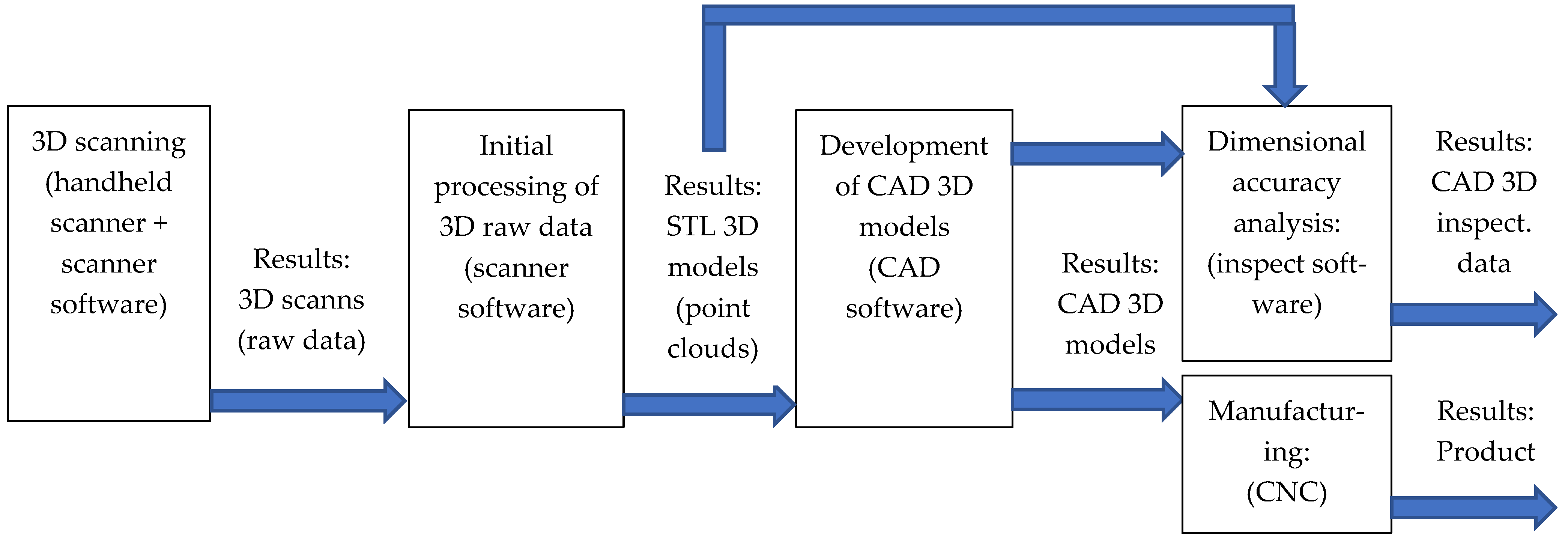
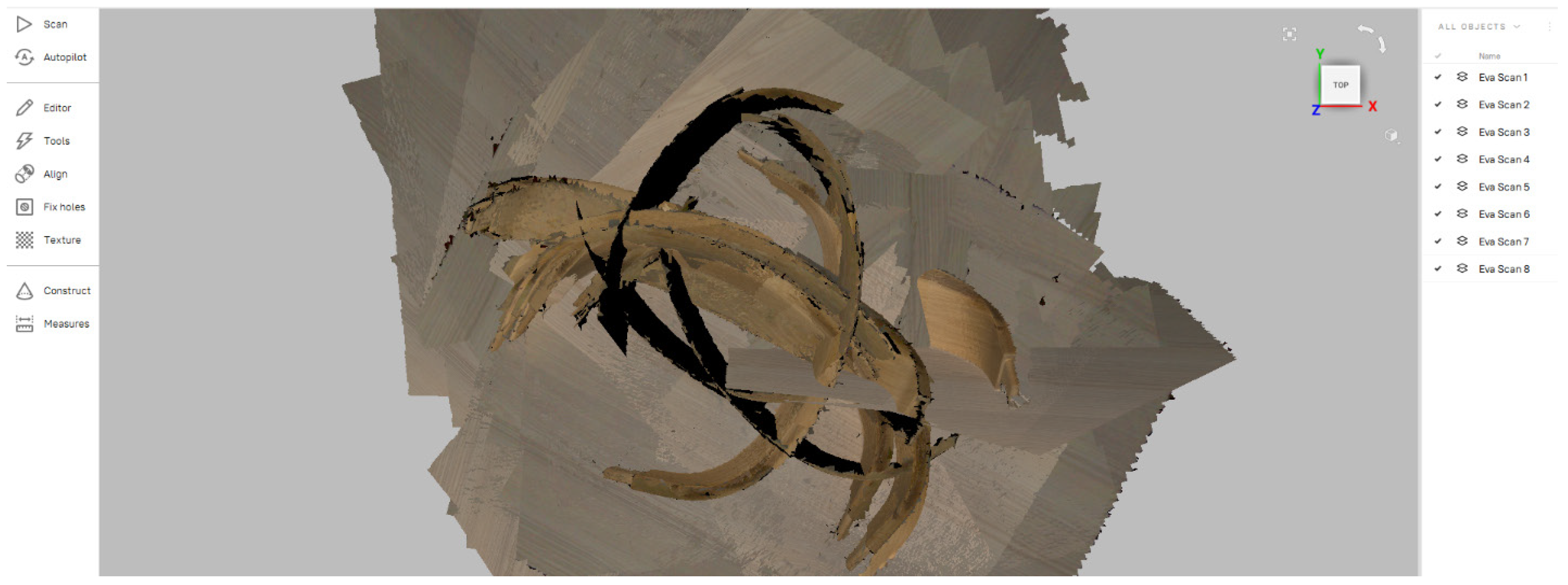

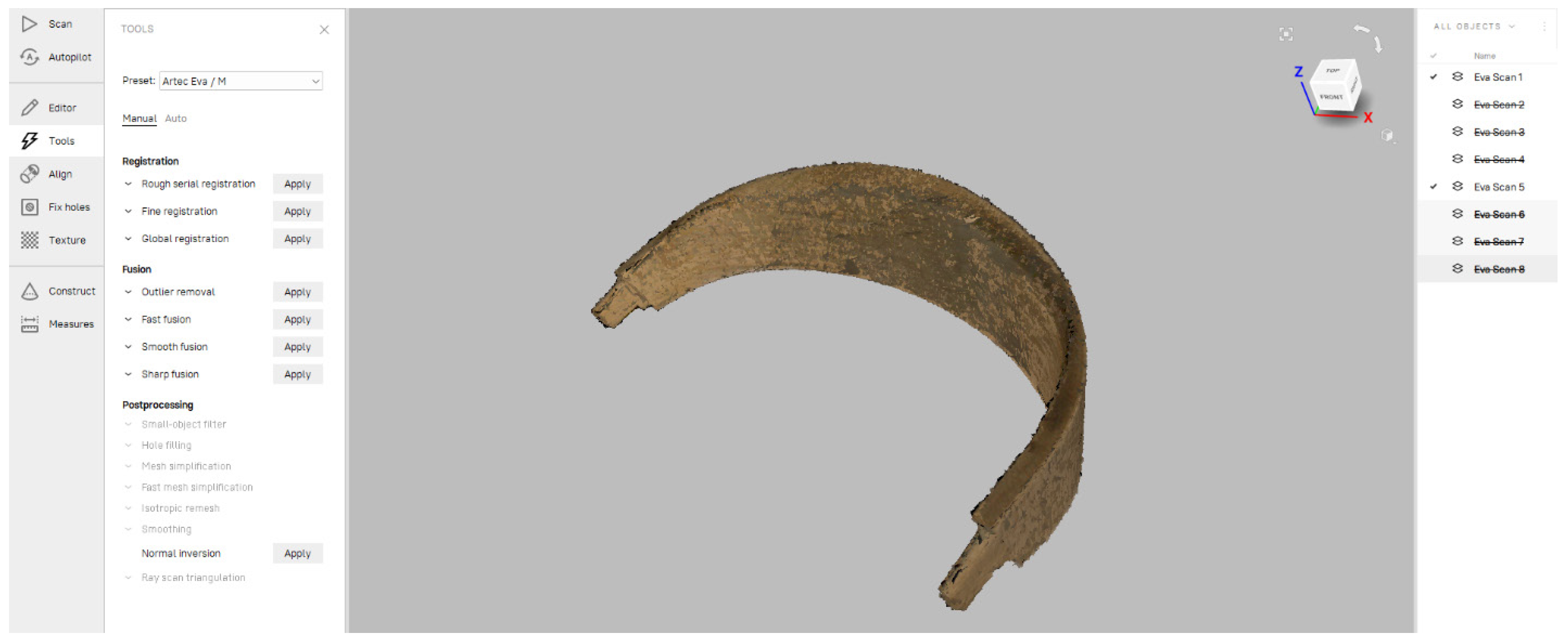
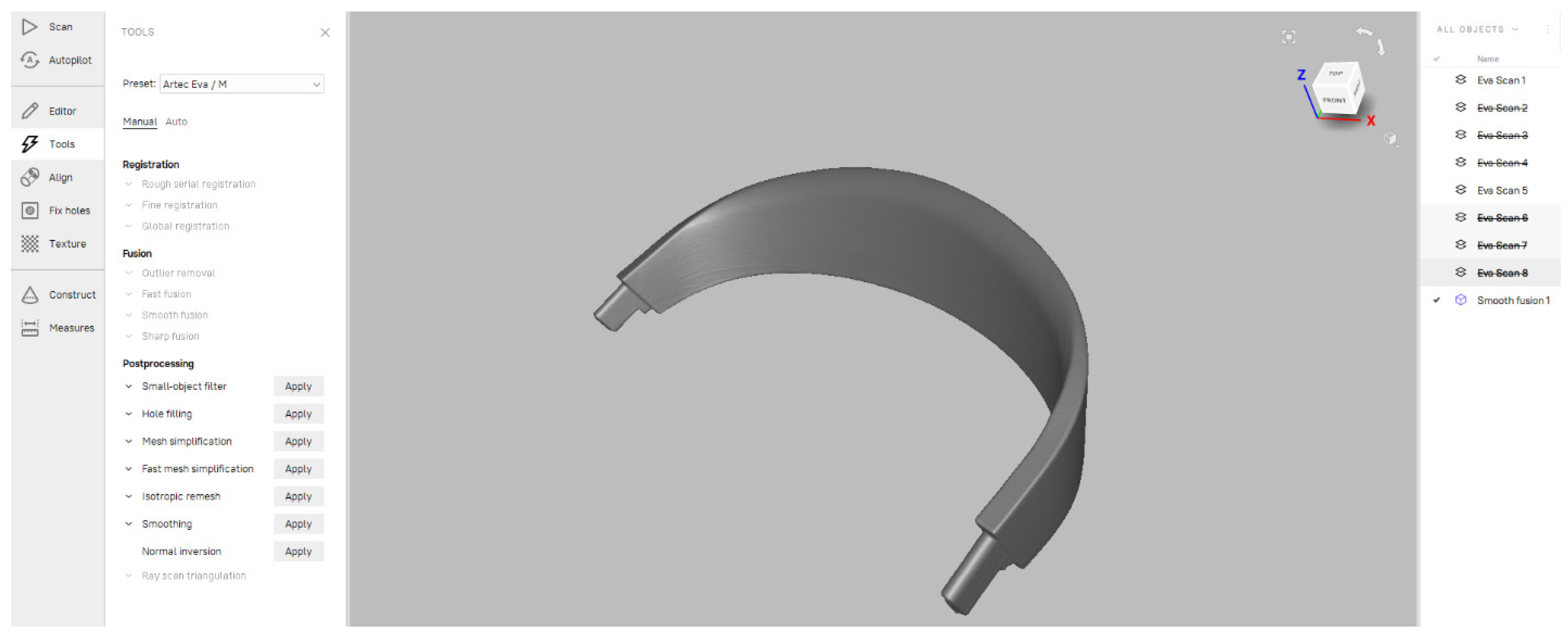

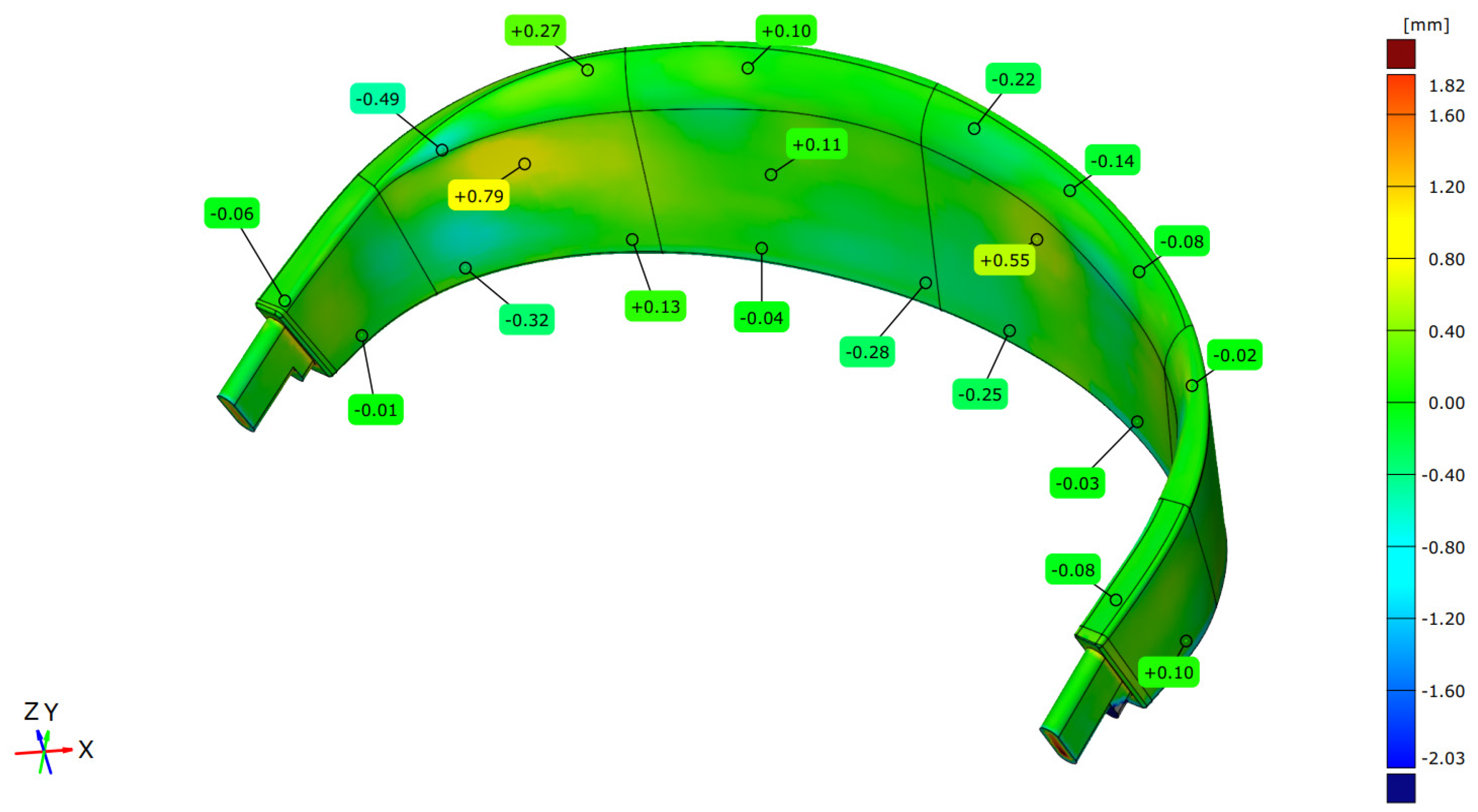
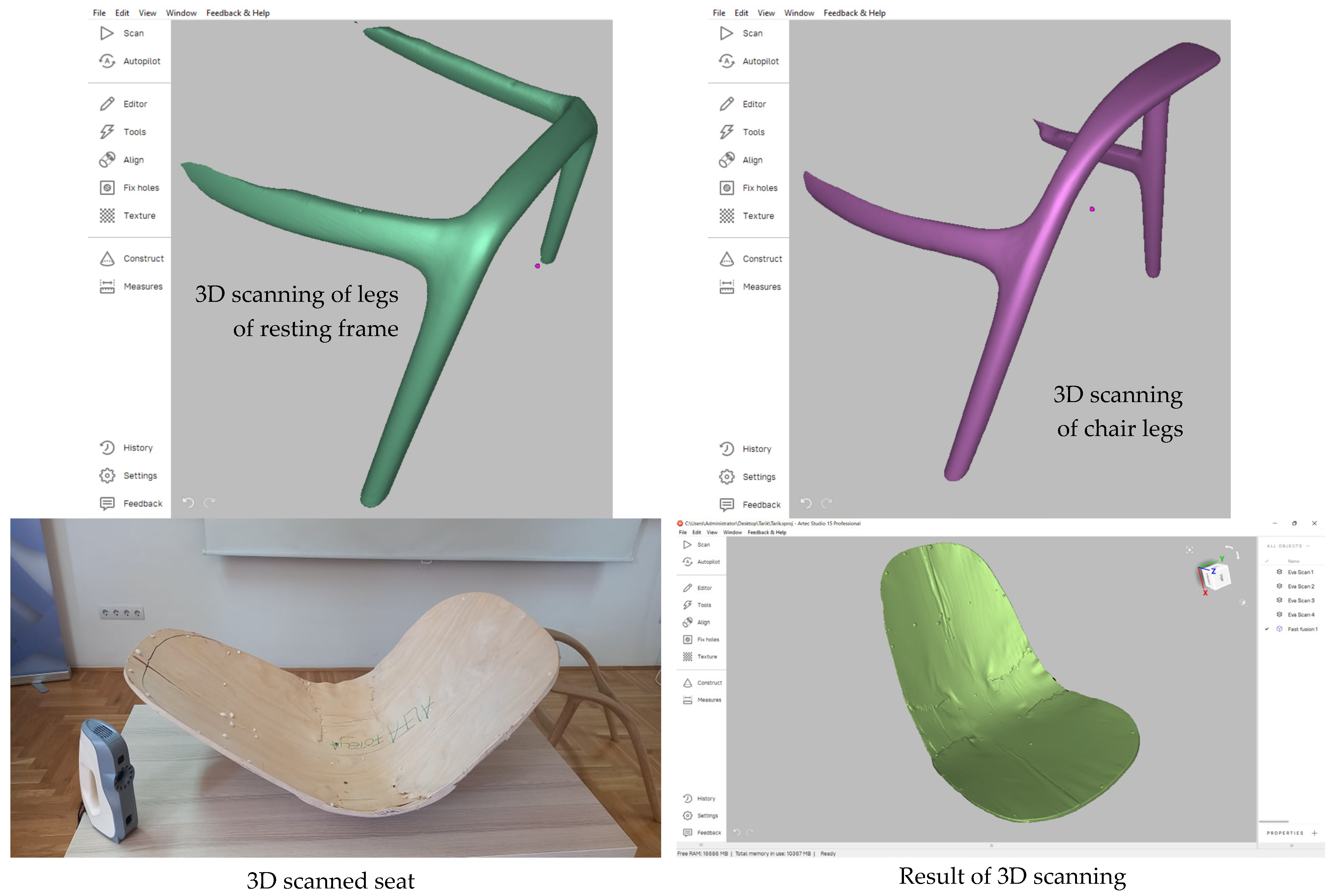
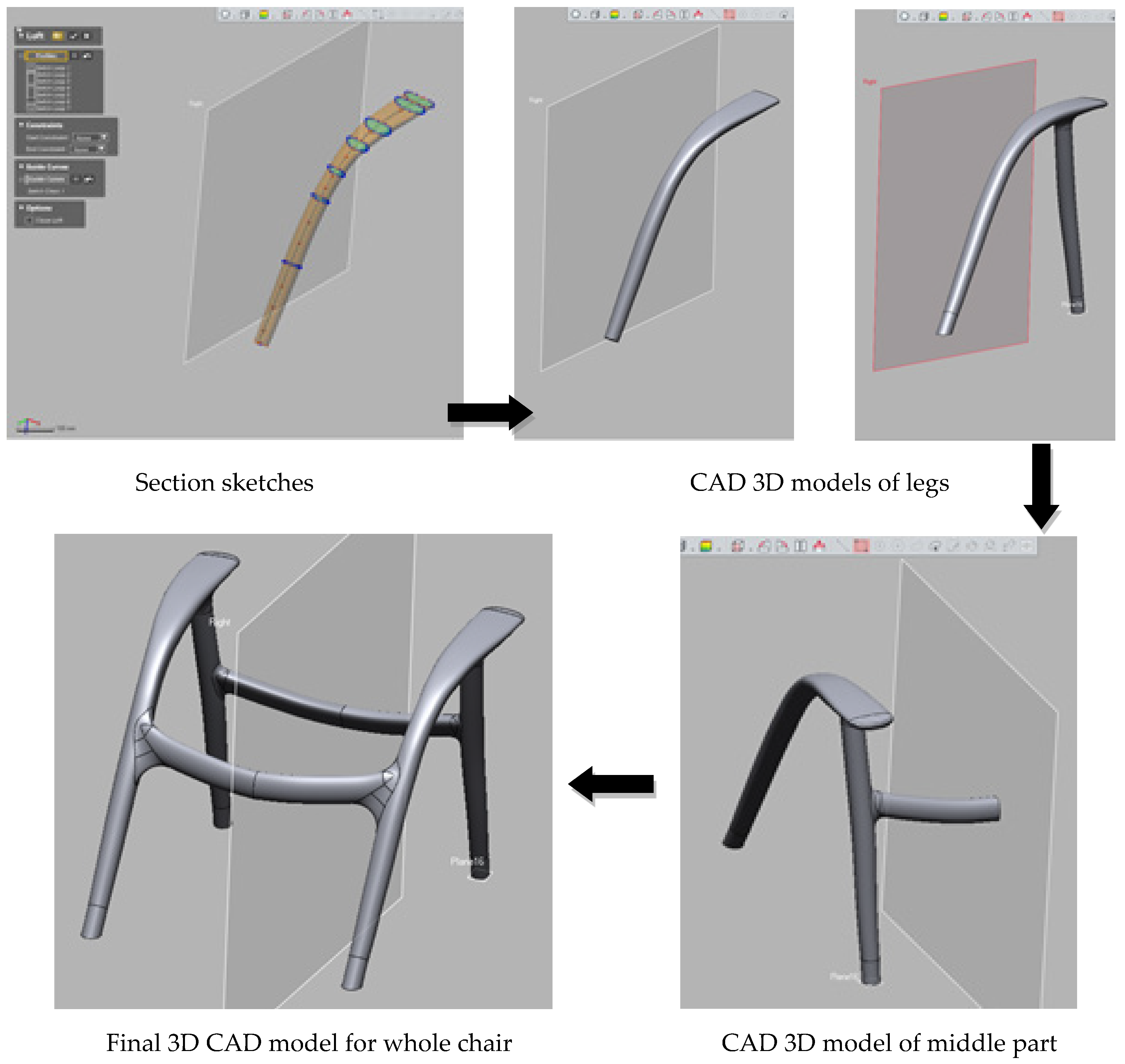
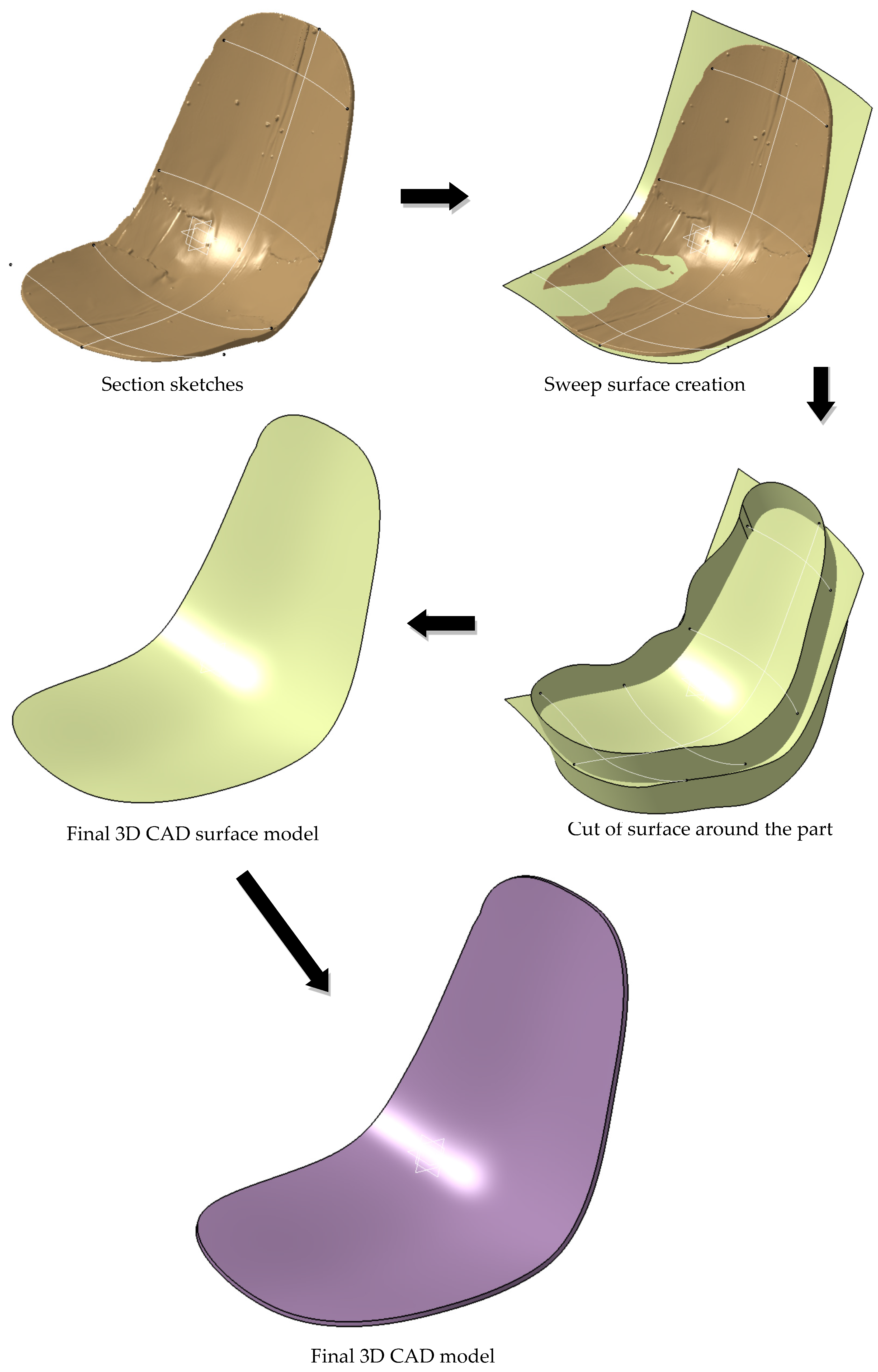
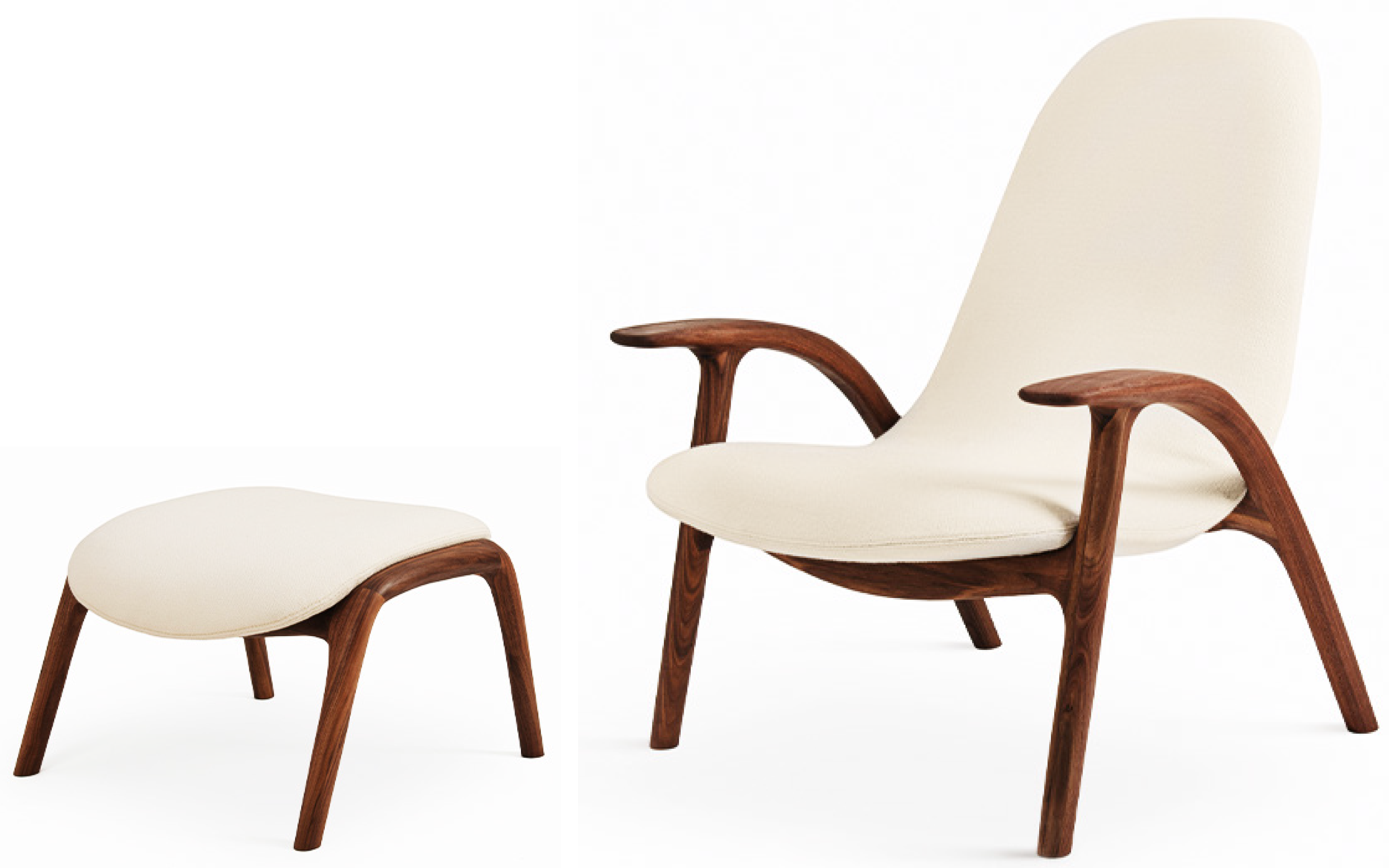
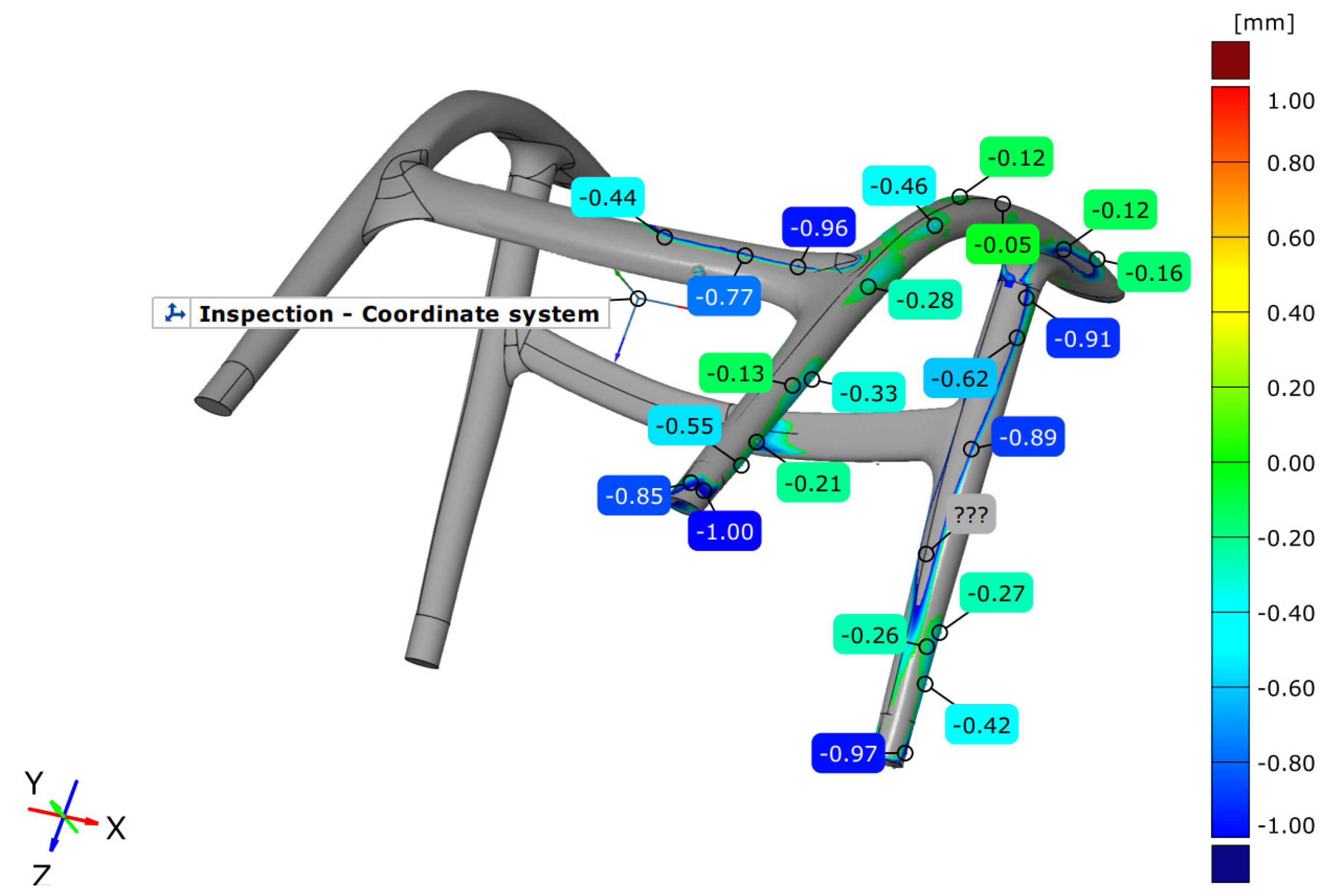
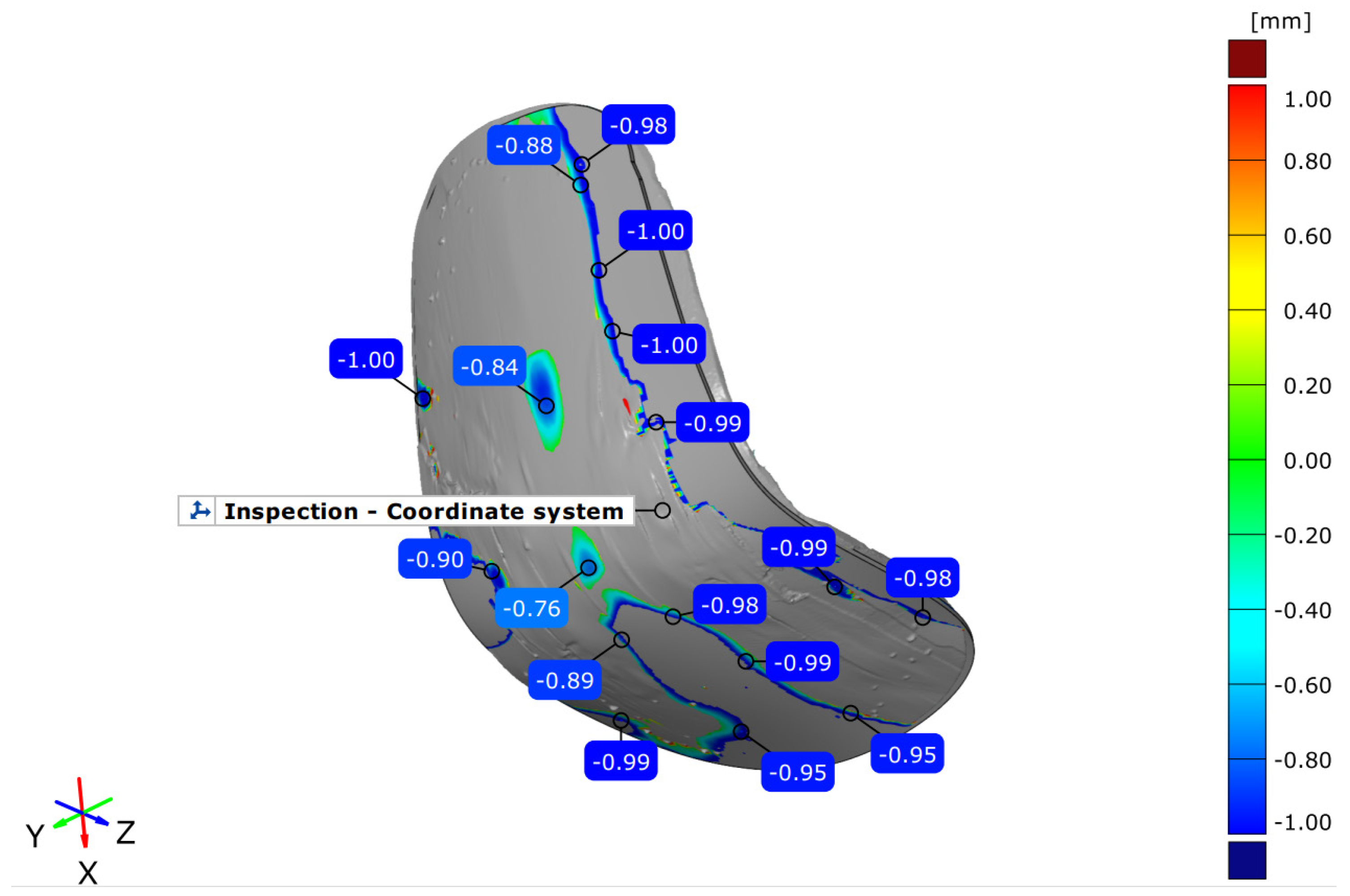

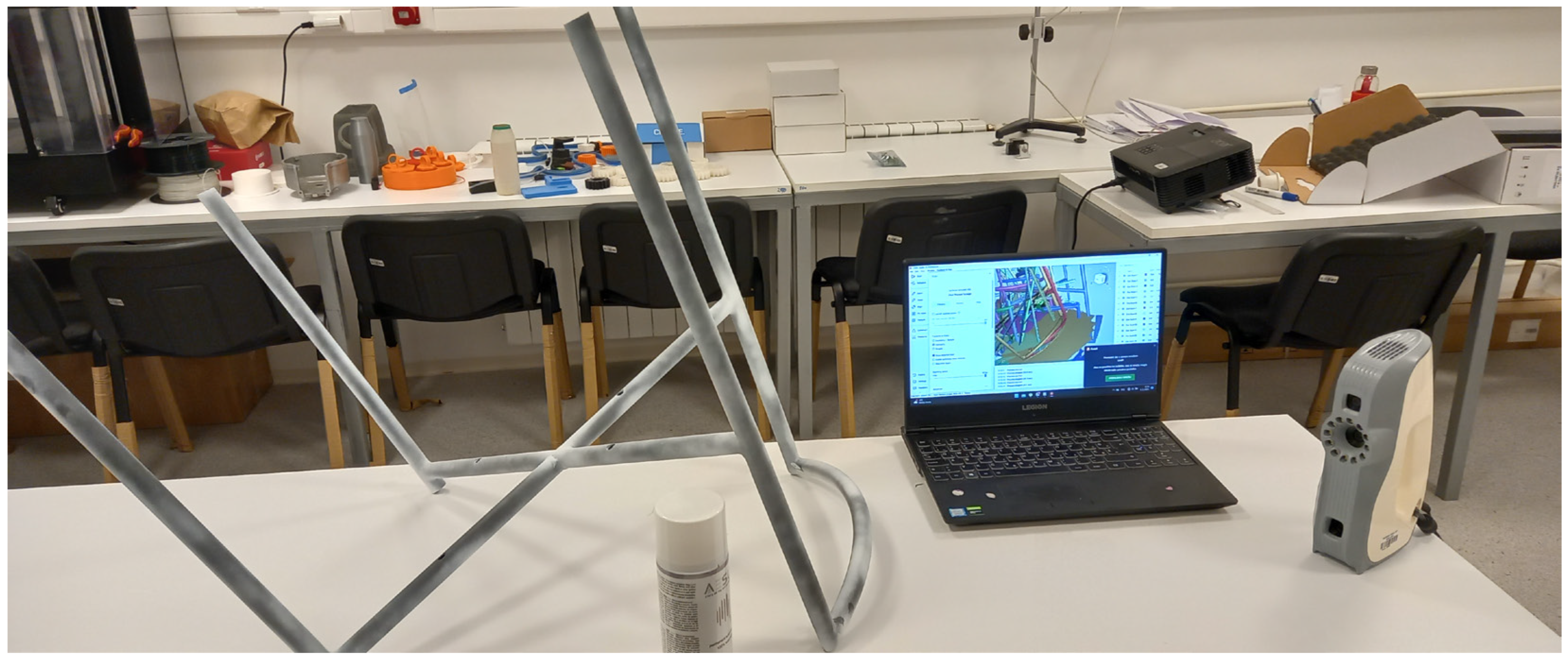
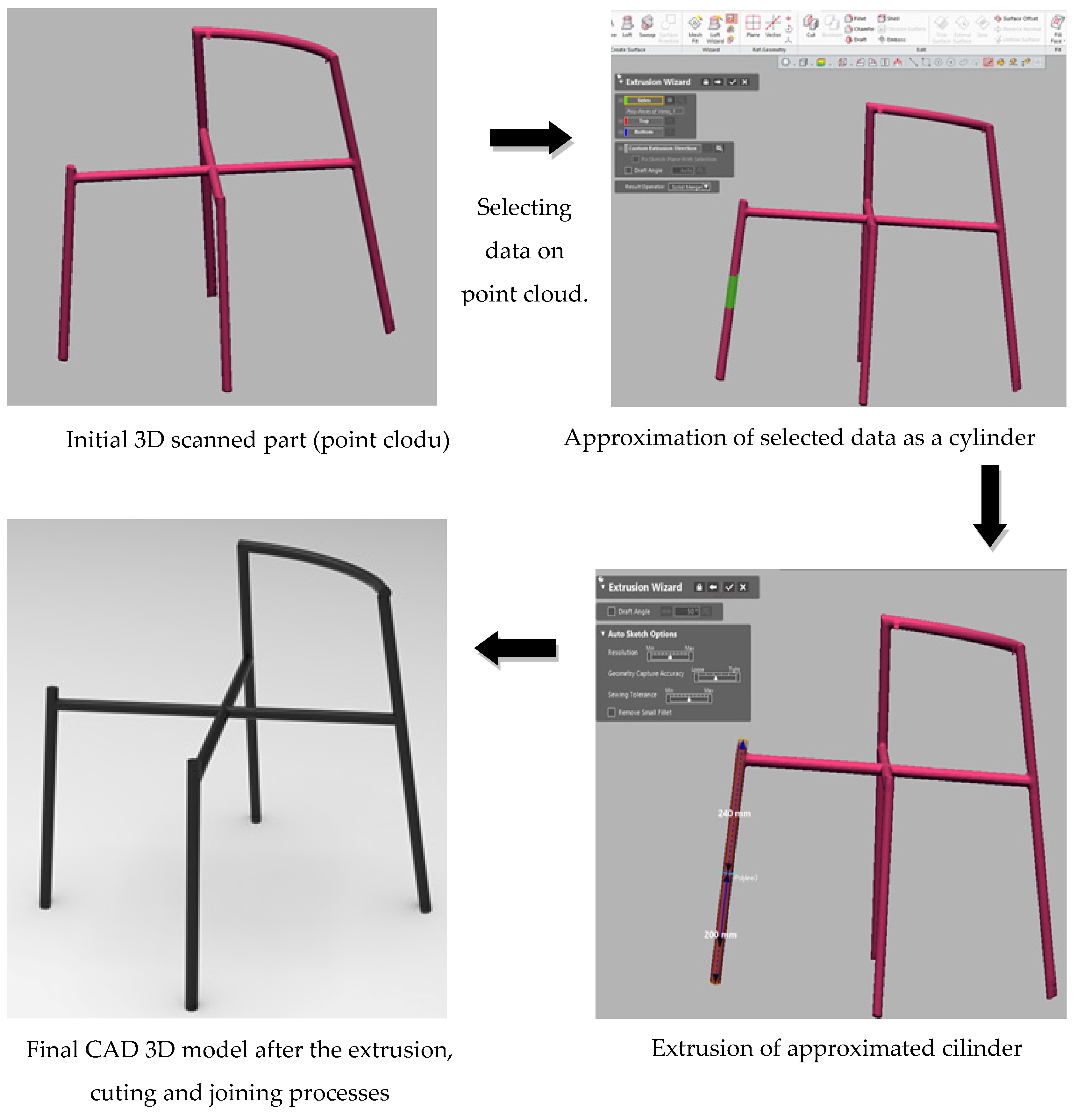
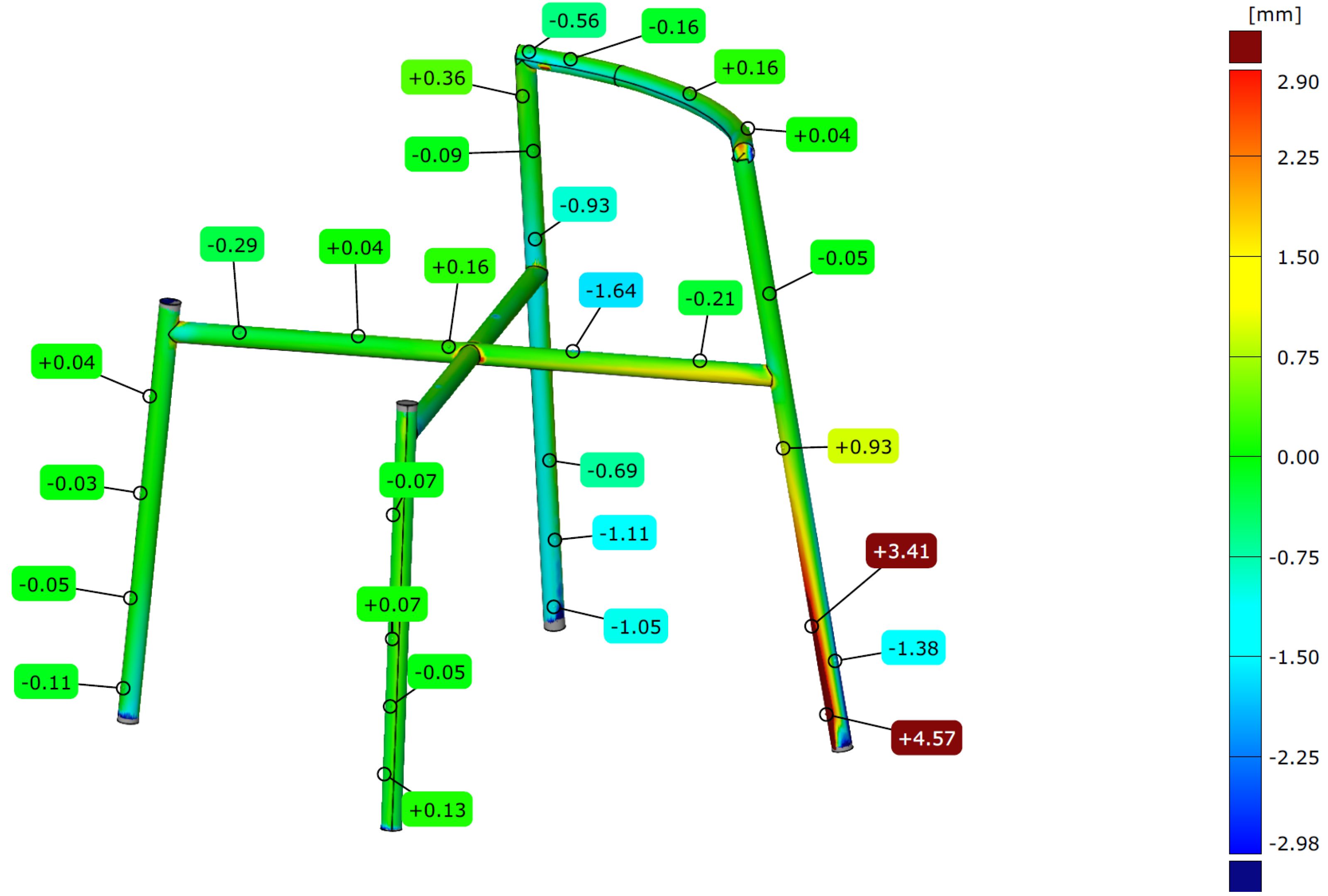
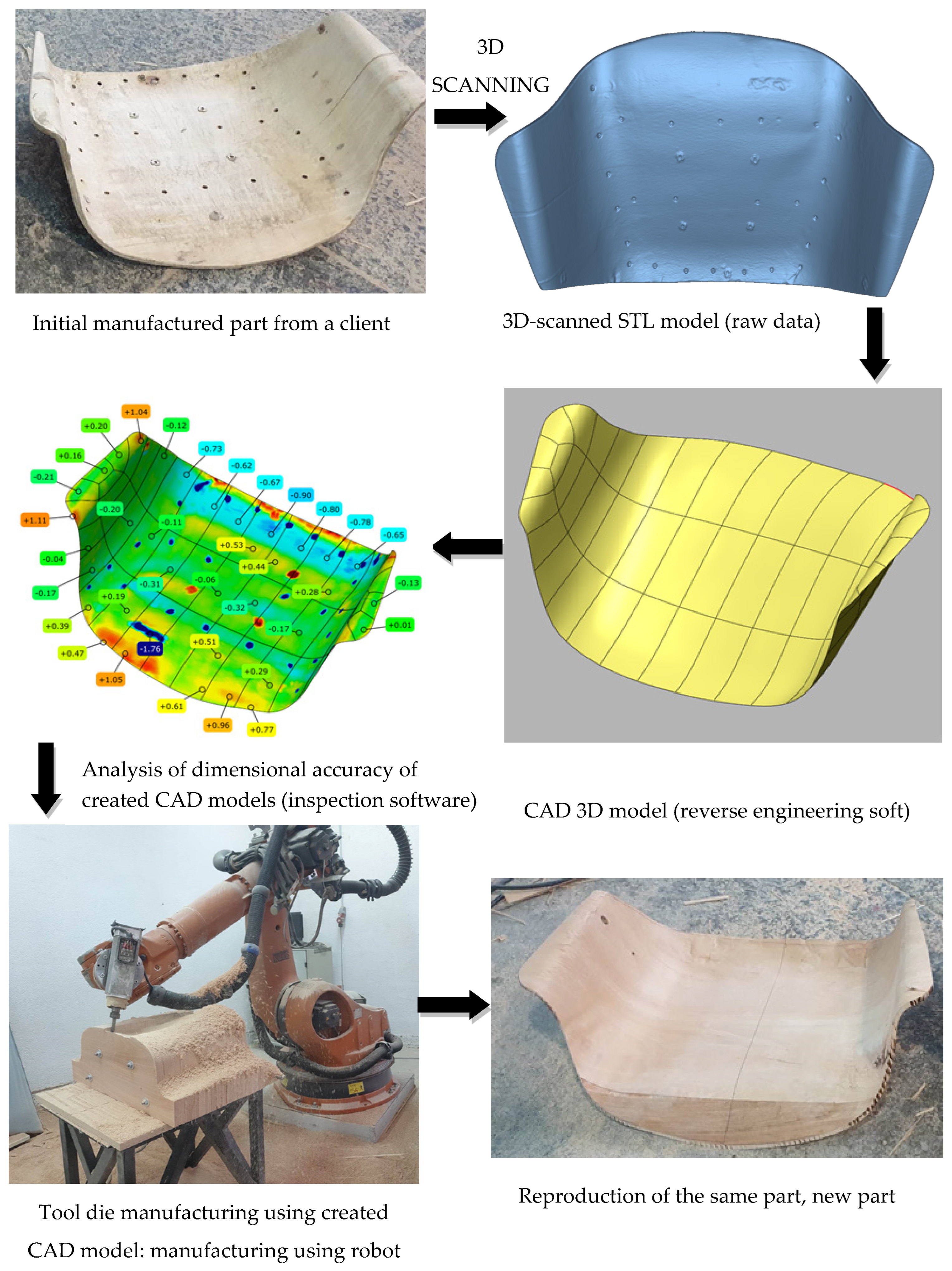
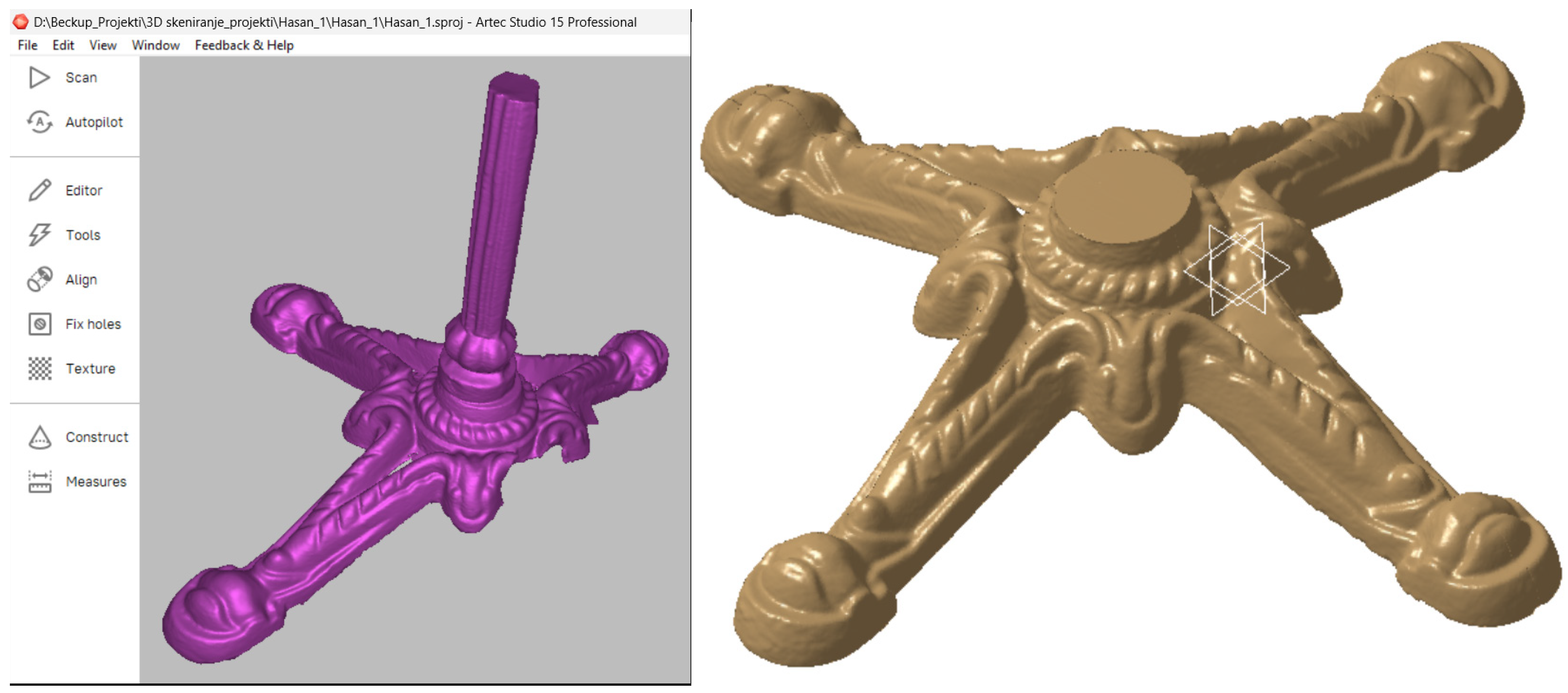
| Technical Specification | Value |
|---|---|
| 3D accuracy | Up to 0.1 mm |
| 3D resolution | Up to 0.2 mm |
| Scanned object size | Larger than 10 cm |
| Full-color scanning | Yes |
| Target-free tracking | Hybrid geometry and color-based |
| 3D reconstruction rate | Up to 16 frames per second |
| Output formats | All popular formats, including STL, OBJ, and PLY |
Disclaimer/Publisher’s Note: The statements, opinions and data contained in all publications are solely those of the individual author(s) and contributor(s) and not of MDPI and/or the editor(s). MDPI and/or the editor(s) disclaim responsibility for any injury to people or property resulting from any ideas, methods, instructions or products referred to in the content. |
© 2024 by the authors. Licensee MDPI, Basel, Switzerland. This article is an open access article distributed under the terms and conditions of the Creative Commons Attribution (CC BY) license (https://creativecommons.org/licenses/by/4.0/).
Share and Cite
Muminović, A.J.; Gierz, Ł.; Rebihić, H.; Smajić, J.; Pervan, N.; Hadžiabdić, V.; Trobradović, M.; Warguła, Ł.; Wieczorek, B.; Łykowski, W.; et al. Enhancing Furniture Manufacturing with 3D Scanning. Appl. Sci. 2024, 14, 4112. https://doi.org/10.3390/app14104112
Muminović AJ, Gierz Ł, Rebihić H, Smajić J, Pervan N, Hadžiabdić V, Trobradović M, Warguła Ł, Wieczorek B, Łykowski W, et al. Enhancing Furniture Manufacturing with 3D Scanning. Applied Sciences. 2024; 14(10):4112. https://doi.org/10.3390/app14104112
Chicago/Turabian StyleMuminović, Adis J., Łukasz Gierz, Hasan Rebihić, Jasmin Smajić, Nedim Pervan, Vahidin Hadžiabdić, Mirsad Trobradović, Łukasz Warguła, Bartosz Wieczorek, Wiktor Łykowski, and et al. 2024. "Enhancing Furniture Manufacturing with 3D Scanning" Applied Sciences 14, no. 10: 4112. https://doi.org/10.3390/app14104112





